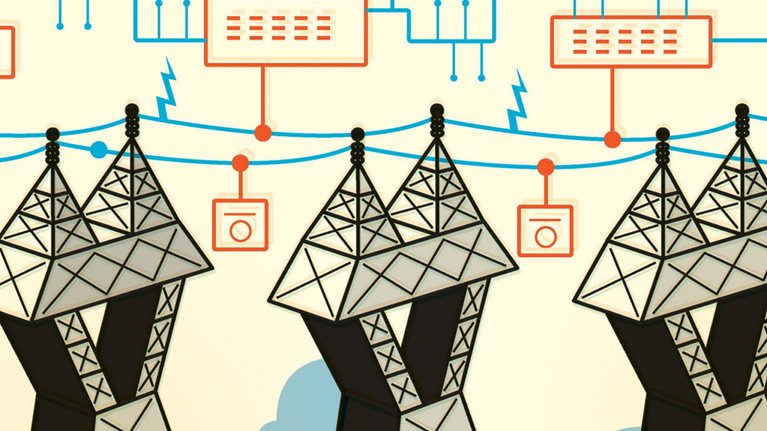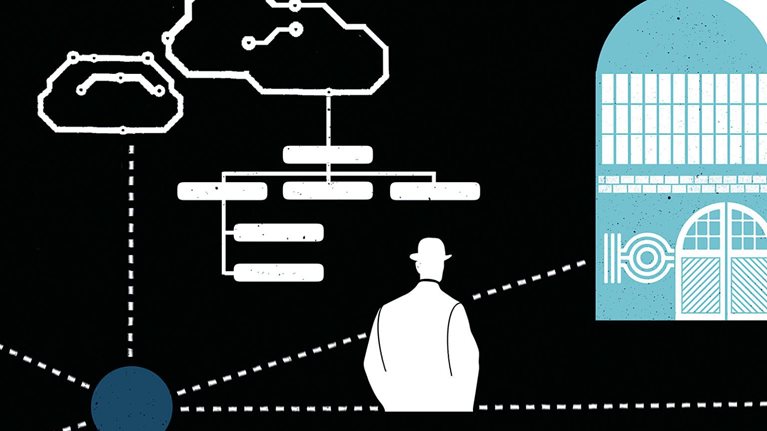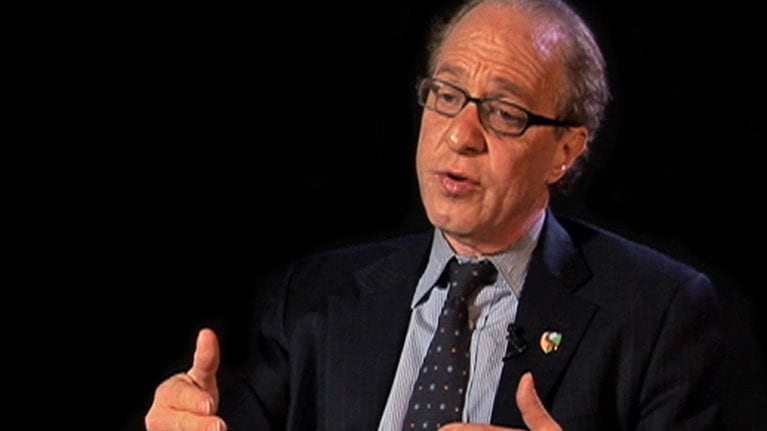In 1850, a decade before the Civil War, the United States’ economy was small—it wasn’t much bigger than Italy’s. Forty years later, it was the largest economy in the world. What happened in-between was the railroads. They linked the east of the country to the west, and the interior to both. They gave access to the east’s industrial goods; they made possible economies of scale; they stimulated steel and manufacturing—and the economy was never the same.
Deep changes like this are not unusual. Every so often—every 60 years or so—a body of technology comes along and over several decades, quietly, almost unnoticeably, transforms the economy: it brings new social classes to the fore and creates a different world for business. Can such a transformation—deep and slow and silent—be happening today?
We could look for one in the genetic technologies, or in nanotech, but their time hasn’t fully come. But I want to argue that something deep is going on with information technology, something that goes well beyond the use of computers, social media, and commerce on the Internet. Business processes that once took place among human beings are now being executed electronically. They are taking place in an unseen domain that is strictly digital. On the surface, this shift doesn’t seem particularly consequential—it’s almost something we take for granted. But I believe it is causing a revolution no less important and dramatic than that of the railroads. It is quietly creating a second economy, a digital one.
Let me begin with two examples. Twenty years ago, if you went into an airport you would walk up to a counter and present paper tickets to a human being. That person would register you on a computer, notify the flight you’d arrived, and check your luggage in. All this was done by humans. Today, you walk into an airport and look for a machine. You put in a frequent-flier card or credit card, and it takes just three or four seconds to get back a boarding pass, receipt, and luggage tag. What interests me is what happens in those three or four seconds. The moment the card goes in, you are starting a huge conversation conducted entirely among machines. Once your name is recognized, computers are checking your flight status with the airlines, your past travel history, your name with the TSA1 (and possibly also with the National Security Agency). They are checking your seat choice, your frequent-flier status, and your access to lounges. This unseen, underground conversation is happening among multiple servers talking to other servers, talking to satellites that are talking to computers (possibly in London, where you’re going), and checking with passport control, with foreign immigration, with ongoing connecting flights. And to make sure the aircraft’s weight distribution is fine, the machines are also starting to adjust the passenger count and seating according to whether the fuselage is loaded more heavily at the front or back.
These large and fairly complicated conversations that you’ve triggered occur entirely among things remotely talking to other things: servers, switches, routers, and other Internet and telecommunications devices, updating and shuttling information back and forth. All of this occurs in the few seconds it takes to get your boarding pass back. And even after that happens, if you could see these conversations as flashing lights, they’d still be flashing all over the country for some time, perhaps talking to the flight controllers—starting to say that the flight’s getting ready for departure and to prepare for that.
Now consider a second example, from supply chain management. Twenty years ago, if you were shipping freight through Rotterdam into the center of Europe, people with clipboards would be registering arrival, checking manifests, filling out paperwork, and telephoning forward destinations to let other people know. Now such shipments go through an RFID2 portal where they are scanned, digitally captured, and automatically dispatched. The RFID portal is in conversation digitally with the originating shipper, other depots, other suppliers, and destinations along the route, all keeping track, keeping control, and reconfiguring routing if necessary to optimize things along the way. What used to be done by humans is now executed as a series of conversations among remotely located servers.
In both these examples, and all across economies in the developed world, processes in the physical economy are being entered into the digital economy, where they are “speaking to” other processes in the digital economy, in a constant conversation among multiple servers and multiple semi-intelligent nodes that are updating things, querying things, checking things off, readjusting things, and eventually connecting back with processes and humans in the physical economy.
So we can say that another economy—a second economy—of all of these digitized business processes conversing, executing, and triggering further actions is silently forming alongside the physical economy.
Aspen root systems
If I were to look for adjectives to describe this second economy, I’d say it is vast, silent, connected, unseen, and autonomous (meaning that human beings may design it but are not directly involved in running it). It is remotely executing and global, always on, and endlessly configurable. It is concurrent—a great computer expression—which means that everything happens in parallel. It is self-configuring, meaning it constantly reconfigures itself on the fly, and increasingly it is also self-organizing, self-architecting, and self-healing.
These last descriptors sound biological—and they are. In fact, I’m beginning to think of this second economy, which is under the surface of the physical economy, as a huge interconnected root system, very much like the root system for aspen trees. For every acre of aspen trees above the ground, there’s about ten miles of roots underneath, all interconnected with one another, “communicating” with each other.
The metaphor isn’t perfect: this emerging second-economy root system is more complicated than any aspen system, since it’s also making new connections and new configurations on the fly. But the aspen metaphor is useful for capturing the reality that the observable physical world of aspen trees hides an unseen underground root system just as large or even larger. How large is the unseen second economy? By a rough back-of-the-envelope calculation (see sidebar, “How fast is the second economy growing?”), in about two decades the digital economy will reach the same size as the physical economy. It’s as if there will be another American economy anchored off San Francisco (or, more in keeping with my metaphor, slipped in underneath the original economy) and growing all the while.
Now this second, digital economy isn’t producing anything tangible. It’s not making my bed in a hotel, or bringing me orange juice in the morning. But it is running an awful lot of the economy. It’s helping architects design buildings, it’s tracking sales and inventory, getting goods from here to there, executing trades and banking operations, controlling manufacturing equipment, making design calculations, billing clients, navigating aircraft, helping diagnose patients, and guiding laparoscopic surgeries. Such operations grow slowly and take time to form. In any deep transformation, industries do not so much adopt the new body of technology as encounter it, and as they do so they create new ways to profit from its possibilities.
The deep transformation I am describing is happening not just in the United States but in all advanced economies, especially in Europe and Japan. And its revolutionary scale can only be grasped if we go beyond my aspen metaphor to another analogy.
A neural system for the economy
Recall that in the digital conversations I was describing, something that occurs in the physical economy is sensed by the second economy—which then gives back an appropriate response. A truck passes its load through an RFID sensor or you check in at the airport, a lot of recomputation takes place, and appropriate physical actions are triggered.
There’s a parallel in this with how biologists think of intelligence. I’m not talking about human intelligence or anything that would qualify as conscious intelligence. Biologists tell us that an organism is intelligent if it senses something, changes its internal state, and reacts appropriately. If you put an E. coli bacterium into an uneven concentration of glucose, it does the appropriate thing by swimming toward where the glucose is more concentrated. Biologists would call this intelligent behavior. The bacterium senses something, “computes” something (although we may not know exactly how), and returns an appropriate response.
No brain need be involved. A primitive jellyfish doesn’t have a central nervous system or brain. What it has is a kind of neural layer or nerve net that lets it sense and react appropriately. I’m arguing that all these aspen roots—this vast global digital network that is sensing, “computing,” and reacting appropriately—is starting to constitute a neural layer for the economy. The second economy constitutes a neural layer for the physical economy. Just what sort of change is this qualitatively?
Think of it this way. With the coming of the Industrial Revolution—roughly from the 1760s, when Watt’s steam engine appeared, through around 1850 and beyond—the economy developed a muscular system in the form of machine power. Now it is developing a neural system. This may sound grandiose, but actually I think the metaphor is valid. Around 1990, computers started seriously to talk to each other, and all these connections started to happen. The individual machines—servers—are like neurons, and the axons and synapses are the communication pathways and linkages that enable them to be in conversation with each other and to take appropriate action.
Is this the biggest change since the Industrial Revolution? Well, without sticking my neck out too much, I believe so. In fact, I think it may well be the biggest change ever in the economy. It is a deep qualitative change that is bringing intelligent, automatic response to the economy. There’s no upper limit to this, no place where it has to end. Now, I’m not interested in science fiction, or predicting the singularity, or talking about cyborgs. None of that interests me. What I am saying is that it would be easy to underestimate the degree to which this is going to make a difference.
I think that for the rest of this century, barring wars and pestilence, a lot of the story will be the building out of this second economy, an unseen underground economy that basically is giving us intelligent reactions to what we do above the ground. For example, if I’m driving in Los Angeles in 15 years’ time, likely it’ll be a driverless car in a flow of traffic where my car’s in a conversation with the cars around it that are in conversation with general traffic and with my car. The second economy is creating for us—slowly, quietly, and steadily—a different world.
A downside
Of course, as with most changes, there is a downside. I am concerned that there is an adverse impact on jobs. Productivity increasing, say, at 2.4 percent in a given year means either that the same number of people can produce 2.4 percent more output or that we can get the same output with 2.4 percent fewer people. Both of these are happening. We are getting more output for each person in the economy, but overall output, nationally, requires fewer people to produce it. Nowadays, fewer people are required behind the desk of an airline. Much of the work is still physical—someone still has to take your luggage and put it on the belt—but much has vanished into the digital world of sensing, digital communication, and intelligent response.
Physical jobs are disappearing into the second economy, and I believe this effect is dwarfing the much more publicized effect of jobs disappearing to places like India and China.
There are parallels with what has happened before. In the early 20th century, farm jobs became mechanized and there was less need for farm labor, and some decades later manufacturing jobs became mechanized and there was less need for factory labor. Now business processes—many in the service sector—are becoming “mechanized” and fewer people are needed, and this is exerting systematic downward pressure on jobs. We don’t have paralegals in the numbers we used to. Or draftsmen, telephone operators, typists, or bookkeeping people. A lot of that work is now done digitally. We do have police and teachers and doctors; where there’s a need for human judgment and human interaction, we still have that. But the primary cause of all of the downsizing we’ve had since the mid-1990s is that a lot of human jobs are disappearing into the second economy. Not to reappear.
Seeing things this way, it’s not surprising we are still working our way out of the bad 2008–09 recession with a great deal of joblessness.
There’s a larger lesson to be drawn from this. The second economy will certainly be the engine of growth and the provider of prosperity for the rest of this century and beyond, but it may not provide jobs, so there may be prosperity without full access for many. This suggests to me that the main challenge of the economy is shifting from producing prosperity to distributing prosperity. The second economy will produce wealth no matter what we do; distributing that wealth has become the main problem. For centuries, wealth has traditionally been apportioned in the West through jobs, and jobs have always been forthcoming. When farm jobs disappeared, we still had manufacturing jobs, and when these disappeared we migrated to service jobs. With this digital transformation, this last repository of jobs is shrinking—fewer of us in the future may have white-collar business process jobs—and we face a problem.
The system will adjust of course, though I can’t yet say exactly how. Perhaps some new part of the economy will come forward and generate a whole new set of jobs. Perhaps we will have short workweeks and long vacations so there will be more jobs to go around. Perhaps we will have to subsidize job creation. Perhaps the very idea of a job and of being productive will change over the next two or three decades. The problem is by no means insoluble. The good news is that if we do solve it we may at last have the freedom to invest our energies in creative acts.
Economic possibilities for our grandchildren
In 1930, Keynes wrote a famous essay, “Economic possibilities for our grandchildren.” Reading it now, in the era of those grandchildren, I am surprised just how accurate it is. Keynes predicts that “the standard of life in progressive countries one hundred years hence will be between four and eight times as high as it is to-day.” He rightly warns of “technological unemployment,” but dares to surmise that “the economic problem [of producing enough goods] may be solved.” If we had asked him and his contemporaries how all this might come about, they might have imagined lots of factories with lots of machines, possibly even with robots, with the workers in these factories gradually being replaced by machines and by individual robots.
That is not quite how things have developed. We do have sophisticated machines, but in the place of personal automation (robots) we have a collective automation. Underneath the physical economy, with its physical people and physical tasks, lies a second economy that is automatic and neurally intelligent, with no upper limit to its buildout. The prosperity we enjoy and the difficulties with jobs would not have surprised Keynes, but the means of achieving that prosperity would have.
This second economy that is silently forming—vast, interconnected, and extraordinarily productive—is creating for us a new economic world. How we will fare in this world, how we will adapt to it, how we will profit from it and share its benefits, is very much up to us.


